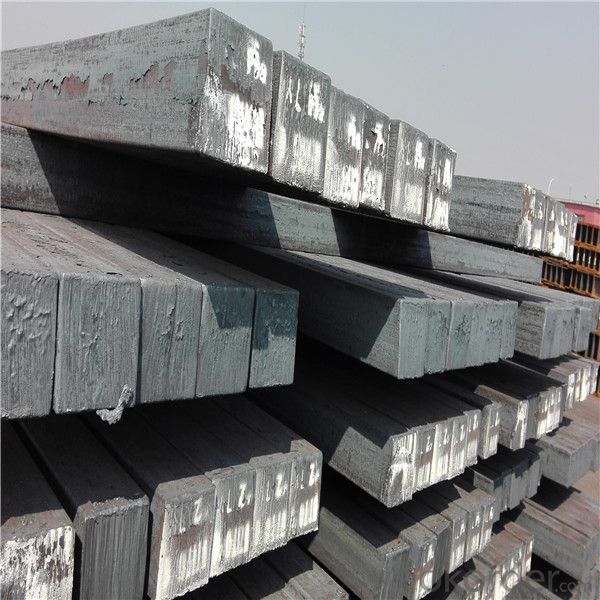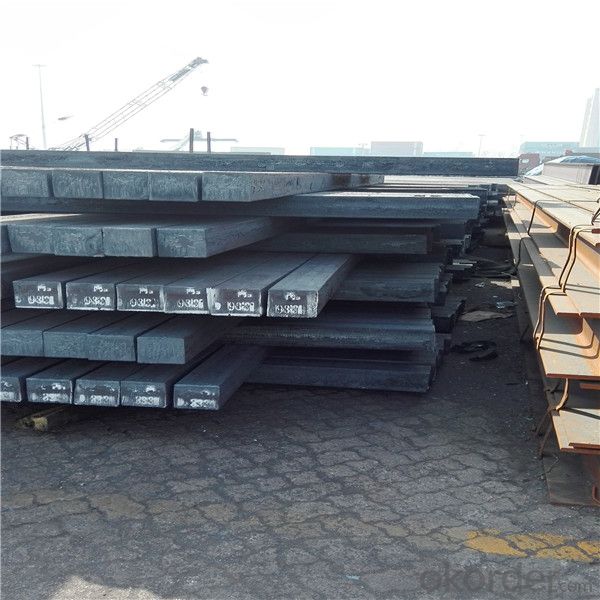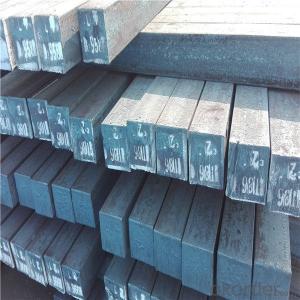Hot rolled square steel billet prime steel
- Loading Port:
- Tianjin
- Payment Terms:
- TT OR LC
- Min Order Qty:
- 1000 m.t.
- Supply Capability:
- 29437 m.t./month
OKorder Service Pledge
OKorder Financial Service
You Might Also Like
Item specifice
Steel billet(ingot) by cogging or breakdown of semi-finished products, is the raw material of all kinds of steel mill. Billet section of square, round, flat, rectangular
and abnormity of several kinds of, mainly related to the shape of rolled products.
Rectangular billet continuous casting billet and mainly general carbon steel, low carbon low silicon cold-rolled material, high quality carbon structural steel, high strength low alloy steel, special steel, etc.
The billet is mainly divided into two kinds from the shape:
Slab: cross section width and height of the ratio of the larger, mainly used for rolling plate.
Size :100mm to 165mm
Length:6~12meters
Grade: Q195/Q215/Q235/Q275
Qaulity:own factory, stable quality
Tolerance: Strictly according to the G/B and JIS standard
Gade:
Standard | C(%) | Mn(%) | S(%) | P(%) | Si(%) |
Q195 | ≤0.12 | ≤0.50 | ≤0.040 | ≤0.035 | ≤0.30 |
Q235 | ≤0.20 | ≤1.40 | ≤0.045 | ≤0.045 | ≤0.35 |
Q275 | ≤0.22 | ≤1.50 | ≤0.045 | ≤0.045 | ≤0.35 |
20MnSi | 0.17-0.25 | 1.2-1.6 | ≤ 0.050 | ≤ 0.050 | 0.40-0.80 |
3SP | 0.14-0.22 | 0.40-0.85 | ≤ 0.050 | ≤ 0.040 | 0.05-0.15 |
5SP | 0.28-0.37 | 0.50-1.00 | ≤ 0.050 | ≤ 0.040 | 0.15-0.30 |



Our service :
We have a plant and professional team to provide our best service, from the start of production until the
loading into the vessel, we have a complete quality follow up procedure, to assure our products arrives to the customer with satisfaction. Welcome new and old customers
to contact us for future business relationships! We will give you a surpise price.
Packing :
Within 30 days
1.Standard export package
2.In bundles with steel strips
3.As the requirements of the customers
FAQ:
Q: What is payment terms?
A: FOB 30% T/T IN ADVANCE AS DEPOSIT AND 70% T/T BEFORE SHIPMENT
CIF and CFR 30% T/T IN ADVANCE AS DEPOSIT AND 70% T/T AS THE COPY OF B/L OR L/C AT SIGHT
Q:How to guarantee the quality of the products?
A:We have established the international advanced quality management system,every link from raw material
to final product we have strict quality test;We resolutely put an end to unqualified products flowing into the market.
At the same time, we will provide necessary follow-up service assurance.
Q:How long can we receive the product after purchase?
A :In the purchase of product within three working days, We will arrange the factory delivery as soon as possible.
The pecific time of receiving is related to the state and position of customers.
- Q:How are steel billets used in the manufacturing of shipbuilding components?
- Steel billets are used in the manufacturing of shipbuilding components as they serve as the raw material for forging, rolling, and shaping various structural parts of a ship, such as hull sections, bulkheads, and frames. These billets are heated and formed into desired shapes through processes like hot rolling, forging, or extrusion, ensuring the required strength, durability, and dimensional accuracy of the shipbuilding components.
- Q:What are the safety precautions to be taken while handling steel billets?
- When handling steel billets, there are several safety precautions that should be followed to ensure the well-being of individuals as well as the integrity of the material. Some key safety precautions include: 1. Personal Protective Equipment (PPE): It is essential to wear appropriate PPE such as gloves, safety glasses, and steel-toed boots to protect against potential injuries. Steel billets are heavy and can cause severe harm if dropped or mishandled. 2. Proper Lifting Techniques: When lifting steel billets, it is crucial to use proper lifting techniques, such as bending at the knees and keeping the back straight. This helps prevent strains, sprains, and other musculoskeletal injuries. 3. Adequate Training: Workers should receive proper training on how to handle steel billets safely. This includes understanding the weight and dimensions of the billets, knowing how to move them safely, and being aware of potential hazards. 4. Secure Storage and Transportation: Steel billets should be stored and transported in a secure manner to prevent accidents. They should be properly stacked, secured, and not overloaded to avoid falling or shifting during handling. 5. Clear Communication: In a work environment where multiple individuals are involved in handling steel billets, clear communication is essential. This includes using appropriate signals and verbal communication to coordinate movements and ensure everyone's safety. 6. Inspect Equipment: Before handling steel billets, it is important to inspect the equipment being used, such as cranes, forklifts, or other lifting devices. This helps identify any potential issues or malfunctions that could compromise safety. 7. Regular Maintenance: Regular maintenance of equipment used for handling steel billets is crucial to ensure their proper functioning. This includes inspections, repairs, and replacements as needed. 8. Hazard Identification: Workers should be trained to identify potential hazards associated with handling steel billets, such as sharp edges, hot surfaces, or slippery floors. Identifying and addressing these hazards promptly can prevent accidents and injuries. 9. Ergonomic Considerations: Ergonomic factors should be considered when designing workstations and handling procedures. This includes ensuring proper height and reach distances, providing adequate space for movement, and using tools or equipment that reduce strain on the body. 10. Emergency Response: Lastly, workers should be aware of emergency response procedures in case of accidents or injuries. This includes knowing the location of first aid kits, fire extinguishers, emergency exits, and how to report incidents to supervisors. By following these safety precautions, individuals can mitigate the risks associated with handling steel billets and create a safer work environment.
- Q:What are the main factors that determine the market price of steel billets?
- The market price of steel billets is influenced by several key factors. Firstly, the demand and supply dynamics play a significant role in determining the market price. If there is a high demand for steel billets and the supply is limited, the price tends to increase. Conversely, if the demand is low and there is an oversupply of steel billets, the price may decrease. Another important factor is the cost of raw materials. Steel billets are primarily made from iron ore, which is subject to price fluctuations in the global market. Increases in the cost of iron ore can drive up the market price of steel billets, as manufacturers pass on the higher production expenses to consumers. Energy costs also impact the market price of steel billets. Steel production is an energy-intensive process, and any fluctuations in energy prices, such as those of coal or natural gas, can influence the final price of steel billets. Additionally, global economic conditions and geopolitical factors can have a significant impact on the market price of steel billets. Economic growth or recession in major steel-consuming countries can affect demand, while trade policies, tariffs, or sanctions imposed by governments can disrupt the supply chain and result in price volatility. Furthermore, technological advancements and innovations in the steel industry can influence the market price as well. Improvements in production processes or the development of new steelmaking techniques can affect the cost of manufacturing steel billets, which can in turn impact the market price. Lastly, currency exchange rates can also affect the market price of steel billets. If the currency of steel-producing countries strengthens against the currencies of steel-consuming countries, it can make the steel billets more expensive for foreign buyers, potentially leading to a decrease in demand and a subsequent decrease in price. In summary, the market price of steel billets is determined by the interplay of supply and demand dynamics, the cost of raw materials and energy, global economic conditions, technological advancements, and currency exchange rates. Being aware of these factors is crucial for both buyers and sellers in the steel billet market to make informed decisions and adapt to changing market conditions.
- Q:How do steel billets contribute to the aerospace industry?
- Steel billets are an essential component in the aerospace industry as they serve as the raw material for manufacturing various critical parts and components. These billets are used to produce high-strength and lightweight steel alloys that are crucial for aircraft structures, such as fuselages, wings, and landing gears. The superior strength and durability of steel billets allow for the construction of robust and reliable aircraft, ensuring safety and performance in demanding aerospace operations.
- Q:How do steel billets compare to other metal billets?
- Steel billets are often considered to be superior to other metal billets due to their unique properties and characteristics. One of the main advantages of steel billets is their exceptional strength and durability. Steel has a high tensile strength, making it resistant to deformation and able to withstand heavy loads and stresses. Additionally, steel billets offer excellent thermal conductivity, which means they can efficiently transfer heat. This property is particularly beneficial in industries such as construction and automotive, where heat dissipation is crucial for the performance and longevity of the end product. Steel billets also have a high melting point, allowing them to withstand extreme temperatures without losing their structural integrity. This makes them suitable for applications that involve exposure to high heat, such as in furnaces or engines. Moreover, steel billets can be easily formed and shaped into various sizes and dimensions, making them highly versatile for a wide range of applications. They can be rolled, forged, or extruded, allowing manufacturers to create different products based on specific requirements. Furthermore, steel billets have excellent corrosion resistance, especially when combined with protective coatings or treatments. This makes them ideal for outdoor applications or in environments where they may be exposed to moisture or chemical substances. In terms of cost-effectiveness, steel billets are often more affordable compared to other metal billets, such as aluminum or titanium. This is due to the abundance of iron ore, the main component of steel, and the efficiency of steel production processes. Overall, steel billets possess a unique combination of strength, durability, thermal conductivity, versatility, and cost-effectiveness that sets them apart from other metal billets. These qualities make steel billets highly desirable in a wide range of industries, including construction, automotive, manufacturing, and infrastructure development.
- Q:What is the drop per minute of the billet temperature at 850?
- Cold rolling is not considered. The initial rolling temperature (surface) of the billet is generally 1000-1150 degrees.
- Q:How are steel billets stored to prevent corrosion?
- Steel billets are typically stored in covered warehouses or under protective tarps to shield them from moisture and exposure to air. Additionally, a corrosion inhibitor such as a rust-preventive coating or oil may be applied to the surface of the billets to create a barrier against oxidation.
- Q:What is the typical production process for steel billets?
- The typical production process for steel billets involves several steps. First, raw materials such as iron ore, coal, and limestone are obtained. These materials are then processed and transformed into iron through a blast furnace or direct reduction process. The iron is further refined in a basic oxygen furnace or an electric arc furnace to remove impurities and adjust the composition. Once the iron is refined, it is cast into large rectangular molds known as ingots. These ingots are then heated and rolled into semi-finished products called blooms or slabs. Blooms are typically square or rectangular in shape, while slabs are flat and rectangular. The next step is to further process the blooms or slabs into billets. This is done by reheating the semi-finished products and passing them through a series of rolling mills. The rolling mills apply pressure to shape the metal and reduce its thickness. This process is known as hot rolling. After hot rolling, the billets are cooled and inspected for any defects. They may undergo additional processes such as surface treatment or heat treatment to improve their properties. The billets are then typically cut into desired lengths and stored before further processing or shipment to customers. Overall, the production process for steel billets involves obtaining raw materials, refining the iron, casting it into semi-finished products, hot rolling, and final inspection and processing. This process ensures that the steel billets meet the required specifications and quality standards before they are used for various applications in industries such as construction, automotive, and manufacturing.
- Q:How are steel billets shaped into rods or wires?
- Steel billets are shaped into rods or wires through a process known as hot rolling. The billets are heated to high temperatures and then passed through a series of rollers, which gradually reduce their size and shape them into the desired rod or wire form. This process allows for precise control over the dimensions and properties of the final product.
- Q:How do steel billets contribute to the overall sustainability of a structure?
- Steel billets contribute to the overall sustainability of a structure in several ways. Firstly, steel is a highly durable and long-lasting material, ensuring the longevity of the structure and reducing the need for frequent repairs or replacements. Additionally, steel is a recyclable material, meaning that steel billets can be melted down and reused in the production of new steel, reducing the demand for virgin materials and the energy required for their extraction and processing. Furthermore, steel has a high strength-to-weight ratio, allowing for lighter and more efficient structures that require fewer materials, resulting in reduced resource consumption and lower carbon emissions throughout the lifecycle of the structure. Overall, the use of steel billets in construction promotes sustainability by optimizing resource efficiency, minimizing waste, and extending the lifespan of structures.
1. Manufacturer Overview |
|
|---|---|
| Location | |
| Year Established | |
| Annual Output Value | |
| Main Markets | |
| Company Certifications | |
2. Manufacturer Certificates |
|
|---|---|
| a) Certification Name | |
| Range | |
| Reference | |
| Validity Period | |
3. Manufacturer Capability |
|
|---|---|
| a)Trade Capacity | |
| Nearest Port | |
| Export Percentage | |
| No.of Employees in Trade Department | |
| Language Spoken: | |
| b)Factory Information | |
| Factory Size: | |
| No. of Production Lines | |
| Contract Manufacturing | |
| Product Price Range | |
Send your message to us
Hot rolled square steel billet prime steel
- Loading Port:
- Tianjin
- Payment Terms:
- TT OR LC
- Min Order Qty:
- 1000 m.t.
- Supply Capability:
- 29437 m.t./month
OKorder Service Pledge
OKorder Financial Service
Similar products
New products
Hot products
Related keywords





























